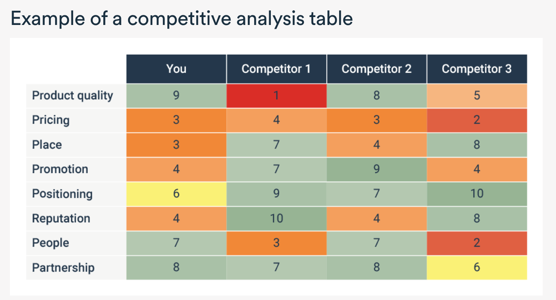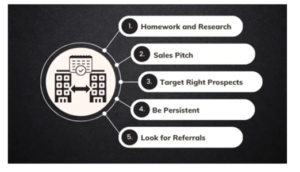Stay on top of your competitors by assessing them at least once a year
To build a successful business, you need to stand out from the competition. That requires some knowledge of who your competitors are and what they bring to the market.
Fortunately, you don’t have to hire a professional market intelligence firm to get that information. You can learn a lot by doing some simple research on your own. BDC Senior Business Advisor Mallika Kazim walks you through the steps involved in conducting a competitive analysis.
What is a competitive analysis?
A competitive analysis is an assessment of your competitors’ products, services and sales tactics, evaluating their strengths and weaknesses relative to your own. It’s good business practice to conduct a full competitive analysis at least once a year.
“You always want to stay on top of what your competitors are doing and where you stand,” Kazim says. “It’s something to make part of your organizational discipline, like keeping good books.”
What is the purpose of a competitive analysis?
A competitive analysis will help you see your own unique advantages as well as any potential barriers to growth so you can strengthen your marketing and business strategies. It also keeps your business proactive instead of reactive. Many entrepreneurs operate based on preconceived ideas about their competitors and market landscape, but those ideas may not be accurate or may be out of date.
“Challenge your assumptions because the data changes all the time,” Kazim says. “Don’t wait until a competitor launches a new product before changing your strategy, otherwise you might end up in a reactive position to market changes. You want to be proactive—and it’s easier to be proactive if you do this exercise regularly.”
How to conduct a competitive analysis in 5 steps
A competitive analysis involves four key steps:
1. Identify your competitors
This sounds straightforward, but in fact there are different kinds of competitors to consider. They include:
- Direct competitors: These are the businesses that offer similar products and services and target the same customers in the geographic area that your business serves.
- Secondary/indirect competitors: These are the businesses that offer different products and services and target a different clientele, but are in your same general category (e.g., a winery and a brewery are secondary competitors because they both sell alcohol).
- Substitute competitors: These are businesses that offer different products and services but target the same customers in your geographic area.
“For an in-person business like a nail salon, home nail kits are an example of substitute competition,” Kazim explains. “During the pandemic, people got used to doing their nails at home. That likely encroached on a lot of salons’ business.”
Sometimes it’s not obvious who your competitors are. In those cases, Kazim recommends using the North American Industry Classification System (NAICS).
With NAICS, every kind of business in Canada is given a six-digit code—from toy stores (NAICS 451120) to tax preparation services (NAICS 541213). You can search the NAICS website by keyword to find the code for your business type. Then you can search for Statistics Canada data tables related to your NAICS code to find information such as average company size, operating expenses and employee wages for your industry. That helps paint a picture of how your business stacks up relative to the rest of your field.
“Those benchmarks can give you some interesting insights,” says Kazim. “You might realize you’re not investing as much in marketing as others in your industry, for example, or your wage costs are way above average.”
2. Gather information about your competitors
Once you’ve identified your competitors, evaluate them in terms of the “four Ps” of the marketing mix:
- Product: Compare their products to your own, ideally by purchasing and trying them out yourself. How is the quality? What features do you like or dislike?
- Pricing: How are their products and services priced? Do their prices vary for channel partners and customers? What is their discount policy? Can you estimate their cost structure?
- Place: What is their geographic reach or service area compared to your business?
- Promotion: What marketing tactics are they using to interact and engage with their customers? What is their presence on social media?
The concept of the “four Ps” has evolved since its invention, so be sure to look at other factors as well, including:
- Positioning: Review their websites, social media, product documents, brochures and catalogues. Who are their target markets? What is their unique selling proposition?
- Reputation: What are people saying about your competitors’ products and services online and on social media? How do the reviews compare to those for your business?
- People: How big is their organization? What is the general profile of the people they employ?
- Partnerships: Who are their suppliers? How long have they been working together?
If you’ve never done this exercise before, Kazim recommends spending a couple of weeks with your sales, marketing and customer service teams to collect the data and do the research. Then, sit down with your team for a focused two-hour session to walk through what you’ve found and map out the results.
In addition to the thorough annual analysis, Kazim says it’s useful to set aside some time every couple of months to do a quick refresh of the data—to ensure you’re always staying proactive instead of reactive.
3. Analyze your competitors’ strengths and weaknesses
During the two-hour session with your team, it’s important that you can easily compare the performance of your competitors with your own. Start by ranking your competitors in the criteria listed above on a scale from 1 to 10, suggests Kazim, using a simple grid/table
Next, prepare a written evaluation of each competitor’s respective strengths and weaknesses. For example, are they popular because of their location? Visibility? Quality of their staff? Are their prices too high? Does their product lack a key feature demanded by customers?
Summarize everything that would make a consumer choose (or not choose) each competitor.
4. Determine your competitive advantage
With all the information at your fingertips, it’s time to figure out what the results mean for your business strategy.
“Ask yourself: what are we good at relative to the competition and where do we want to focus?” says Kazim. “It’s a little bit of a ‘who do you want to be when you grow up?’ kind of question.”
Analyzing the competitive landscape will help pinpoint your competitive advantage. It could be a distinctive strength that appeals to your target market and something you can build your brand image and messaging around. Or if you see a weakness in the competition, you could lower your prices and launch new promotions to take advantage of the opportunity.
That said, while it’s important to keep tabs on the competition and improve your business in response, Kazim says you shouldn’t allow concerns about what others are doing to fully dictate or dominate your strategy.
Further tips for conducting a competitive analysis
If you’re conducting your first competitive analysis, don’t worry about being perfectly accurate or drilling down in minute detail. It’s more important to get an actionable sense of the competitive landscape and the general patterns shaping your market, says Kazim. She also encourages taking a holistic perspective.
“Many entrepreneurs tend to focus only on pricing and products,” she says. “But you need to look at everything that affects where your competitors stand in the market: how their customers are changing, whether they’re investing in their businesses and so on. Forming a complete picture of your competitors gives you that much more decision-making insight.”
Ideally, your analysis will feature at least one or two direct competitors in the mix. But what if there are no direct competitors in your immediate geographic service area? This can be an issue for many smaller entrepreneurs, especially if they have a very niche product or service. In this case, you can still do a competitive analysis—you’ll just need to think outside the box and look more closely at the substitute competitors who might “steal wallet share” from your customers. You can also look to other cities or regions to get a comparative benchmark.
“If you’re the only nail shop in your small town, keep an eye on what is happening with the nail shop in the next town over and see how you measure up,” Kazim advises.











